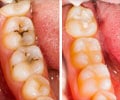Modern Anesthetics in Dental Anesthesia
The modern anesthetics owe a lot to
Most of these agents produce adequate
| Ester group | Anilide group |
| Cocaine | Bupivacaine |
| Benzocaine | Etidocaine |
| Procaine | Lidocaine (Most Commonly Used) |
| Tetracaine | Mepivacaine |
A typical anesthetic solution contains lidocaine, adrenaline, methyl paraben, sodium meta-bisulphate, sodium chloride and water to make the solution. Adrenaline is a vasoconstrictor, meaning that it constricts the vessels, thereby prolonging the action of the anesthetic. The other chemicals are reducing agents to lidocaine hydrochloride and adrenaline.











